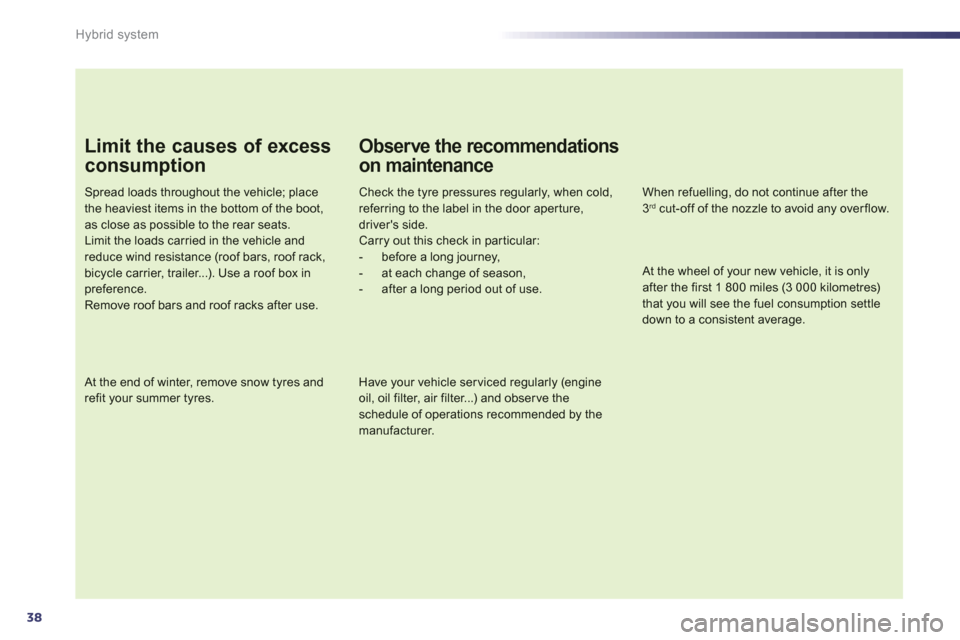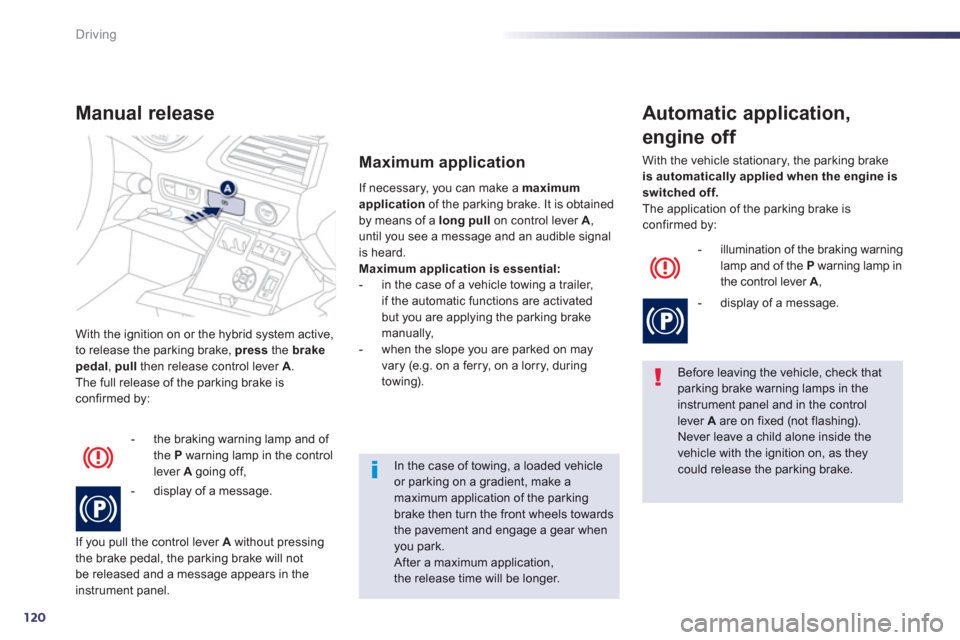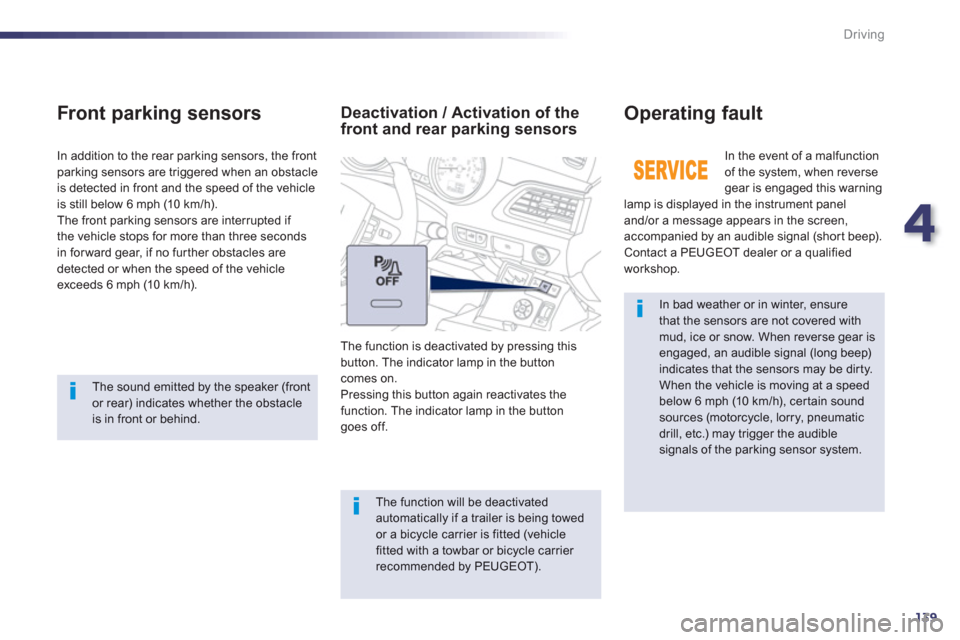Page 5 of 304
.
.
Contents
Child seats 158
ISOFIX child seats 164
Child lock 167
Child safety
Direction indicators 168
Emergency or assistance call 169
Horn 169
ESP system 170
Seat belts 173
Airbags 176
Safety
Te m p o r a ry puncture repair kit 180
Changing a wheel 186
Changing a bulb 191
Changing a fuse 198
12 V battery 202
Energy economy mode 205
Changing a wiper blade 206
Recovering the vehicle 207
Vehicle recovery 209
To w i ng a trailer 210
Fitting roof bars 212
Accessories 213
Practical information
Opening the bonnet 216
Running out of fuel (Diesel) 217
Diesel engine 218
Checking levels 219
Checks 222
Checks
Electric motor 225
Diesel engine 226
Diesel weights 227
Dimensions 228
Identifi cation markings 229
Technical data
Emergency or assistance 231
JBL equipment 233
Peugeot Connect Navigation (RT6) 235
Audio equipment and telematics
Alphabetical index
Visual search
Page 40 of 304

38
Hybrid system
Limit the causes of excess
consumption
Spread loads throughout the vehicle; placethe heaviest items in the bottom of the boot,as close as possible to the rear seats.Limit the loads carried in the vehicle andreduce wind resistance (roof bars, roof rack,bicycle carrier, trailer...). Use a roof box in preference.Remove roof bars and roof racks after use.
At the end of winter, remove snow tyres and refit your summer tyres.
Observe the recommendations
on maintenance
Check the tyre pressures regularly, when cold, referring to the label in the door aper ture, driver's side. Carry out this check in par ticular:
- before a long journey,
- at each change of season,
- after a long period out of use.
Have your vehicle ser viced regularly (engine oil, oil filter, air filter...) and obser ve the schedule of operations recommended by the
manufacturer.
When refuelling, do not continue after the3 rd
cut-off of the nozzle to avoid any overflow.
At the wheel of your new vehicle, it is onlyafter the first 1 800 miles (3 000 kilometres) that you will see the fuel consumption settle down to a consistent average.
Page 46 of 304
44
Hybrid system
Vehicle recovery
position N
, then switch off the hybrid system.
If necessary because access to the vehicle is difficult, it can be moved a few dozen metres at a speed not exceeding 6 mph (10 km/h).
Th
e front or rear wheels must not be on theground, use a flat-bed lorry or trailer to recover
the vehicle.
Use the towin
g eyes only to pull a vehicle out or
to pull it onto a flat-bed.
Page 122 of 304

120
Driving
With the ignition on or the hybrid system active,
to release the parking brake, pressthe brakepedal, pull
then release control lever A.
The full release of the parking brake is confirmed by:
Manual release
- the braking warning lamp and of
the P warning lamp in the controllever A
going off,
- displa
y of a message.
I
f you pull the control lever Awithout pressing
the brake pedal, the parking brake will not
be released and a message appears in the
instrument panel. If necessar
y, you can make a maximum
applicationof the parking brake. It is obtained by means of a long pullon control lever A,
until you see a message and an audible signal is heard.Maximum application is essential:
- in the case of a vehicle towing a trailer,
if the automatic functions are activatedbut you are applying the parking brake
manually,
- when the slope you are parked on mayvary (e.g. on a ferry, on a lorry, during
towing).
Maximum application
Before leaving the vehicle, check that parking brake warning lamps in the instrument panel and in the control lever Aare on fixed (not flashing).
Never leave a child alone inside thevehicle with the ignition on, as they could release the parking brake.
Automatic application,
en
gine off
- illumination of the braking warning
lamp and of the Pwarning lamp in
the control lever A ,
- displa
y of a message.
With the vehicle stationary, the parking brake is automatically applied when the engine is
switched off. The application of the parking brake is confirmed by:
In the case of towing, a loaded vehicleor parking on a gradient, make amaximum application of the parkingbrake then turn the front wheels towards the pavement and engage a gear whenyou park.
After a maximum application,the release time will be longer.
Page 141 of 304

4
139
Driving
In bad weather or in winter, ensure that the sensors are not covered with mud, ice or snow. When reverse gear isengaged, an audible signal (long beep)indicates that the sensors may be dirty.
When the vehicle is moving at a speed below 6 mph (10 km/h), cer tain soundsources (motorcycle, lorry, pneumatic
drill, etc.) may trigger the audible signals of the parking sensor system.
In th
e event of a malfunction
of the system, when reversegear is engaged this warning
lamp is displayed in the instrument panel
and/or a message appears in the screen,
accompanied by an audible signal (short beep).
Contact a PEUGEOT dealer or a qualified
wor
kshop.
Operating fault
In addition to the rear parking sensors, the front
parking sensors are triggered when an obstacle
is detected in front and the speed of the vehicle
is still below 6 mph
(10 km/h).
The front parking sensors are interrupted if
the vehicle stops for more than three seconds
in
forward gear, if no fur ther obstacles are
detected or when the speed of the vehicle exceeds 6 mph (10 km/h).
Front par king sensors
The function will be deactivated automatically if a trailer is being towedor a bicycle carrier is fitted (vehicle fitted with a towbar or bicycle carrier recommended by PEUGEOT).
Deactivation / Activation of thefront and rear parking sensors
The function is deactivated by pressing this
button. The indicator lamp in the button
comes on.
Pressing this button again reactivates thefunction. The indicator lamp in the buttongoes off.
The sound emitted by the speaker (frontor rear) indicates whether the obstacle is in front or behind.
Page 202 of 304
200
Practical information
Dashboard fuses
The fusebox is placed in the lower dashboard (right-hand side).
Access to the fuses
�)Open the folding panel then apply pressure
to bypass the stops.
Fuse N°Rating (A)Functions
F
315 Driver's electric window panel, 12 V socket for rear seats.
F
415 12 V socket in boot.
F530 One-touch rear window.
F
630 One-touch front window.
F1
120
Trailer unit.
F12 20
Audio am
plifier.
F1
520
Panoramic sunroof blind (SW).
F1
65 Driver's electric window switch panel.
Page 209 of 304
8
207
Practical information
Recovering the vehicle on a fl at-bed
From the front Access to the tools
The towing eye is located behind the rear seats. �)For access to it, fold the 2/3 par t of the rear seats.
�)
On the front bumper, unclip the cover bypressing at the bottom to disengage the securing lugs. �)
Screw the towing eye in fully. �)
Install the towing system. �)
Switch on the hazard warning lamps.
Always recover the vehicle on a flat bed lorry or trailer.Never tow the vehicle with the four wheels on the ground (or the front or rear wheels only), you risk damaging the transmission.Place the gear selector in position Nand switch off the engine (Readylamp off).�)
Place the gear selector in neutral - position N .
Failure to obser ve this special condition could result in damage to cer tainbraking components and the absence of braking assistance the next time the engine is star ted.
Procedure for havin
g your vehicle recovered on a flat bed lorry or trailer.
Page 211 of 304
8
209
Practical information
Vehicle recovery
Before doing any work, with the ignition on, press the brake pedal and put the gear selector toposition N, then switch off the hybrid system.
If necessary because access to the vehicle is difficult, it can be moved a few dozen metres at a speed not exceeding 6 mph (10 km/h).
Th
e front or rear wheels must not be on theground, use a flat-bed lorry or trailer to recover
the vehicle.
Use the towing eyes only to pull a vehicle out or
to pull it onto a flat-bed.